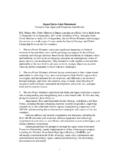Transcription of Strategies for Multi Story Homes: A Quick Guide for ...
1 SMUD home Performance Program Comfort Strategies for Multi Story Homes Efficiency First California | cbpca 1 December 2014 Comfort Strategies for Multi Story Homes: A Quick Guide for ContractorsThere are three Strategies for delivering comfort and energy efficiency to Multi Story homes: 1. Zoning a single HVAC system 2. Adding a second HVAC system 3. Installing a ductless mini split system SMUD home Performance Program offers rebates for mini split system installations ($250 rebate for each indoor head installed [maximum of four heads]) and new HVAC equipment including adding a second system.
2 Comfort and Multi Story Homes Houses over 2,000 square feet with two or more floors and high cooling loads in the summer or high heating loads in the winter are good candidates for an HVAC system upgrade. In addition to seasonal impacts, in a typical two Story home the heating/cooling load commonly differs from floor to floor and room to room. For example, the top floor and south facing rooms of the house may require more cooling and less heating load than bottom floor and north facing rooms. Zoning has the capability of diverting more of the HVAC capacity to the area with the higher load, according to the Residential Zoned Ducted HVAC Systems CASE 1 Residential Zoned Ducted HVAC Systems, Rick Chitwood, John Proctor, and Bruce Wilcox, September 2011.
3 Option 1: Zoning an single HVAC system Creating separate zones within an existing single HVAC system means the system can respond to different loads throughout the house. Known as a dual zone or Multi zone system, zoning helps balance the airflow as loads change from winter to summer, morning to afternoon, day to night, and upstairs to downstairs and address a range of different heating/cooling needs, such as rooms with south and west facing windows, rooms with high or vaulted ceilings, and basements. COMPONENTS OF A Multi ZONE HVAC SYSTEM.
4 Regardless of the equipment type, the components needed to zone a single HVAC system are: Main HVAC system with furnace, air conditioner, coil, and duct system. (Typically, you will be dealing with an existing HVAC system.) Electronic zoning dampers: One damper per zone; a typical zoned system will include 3 to 4 electronic dampers. Dampers should be installed near the plenum. Smart zoning thermostats: One thermostat for each zone; these thermostats usually come with a control board. Zone control board and sensors Extra return air duct: Not always needed, but generally recommended.
5 GOOD SYSTEM DESIGN IS IMPORTANT. Zoning is a science. You cannot just add a damper and wing it. The contractor must use building science techniques to design a system that will (1) support the required airflow, (2) protect the equipment, and (3) effectively address a variety of fan speed issues and technologies (for example, varying speed ranges, dipswitches, ramping profiles, and active control boards). Zoning works best with thoughtful design and installation. Zoning is an effective way to increase comfort because a Multi zoned system keeps temperatures closer to the set point without overheating or overcooling areas with different loads.
6 BEST PRACTICES RESOURCES FOR EFFECTIVE DESIGN. Zoning best practices are provided in the following two major resources. The 2013 California Building Code Residential Compliance Manual recommends the following best practices to optimize airflow in Multi zoned systems: Comfort Strategies for Multi Story Homes: A Quick Guide for Contractors SMUD home Performance Program Comfort Strategies for Multi Story Homes Efficiency First California | cbpca 2 December 2014 1. In every zonal control mode, the system should provide airflow through the return grilles that is equal to or greater ( ) than 350 CFM per ton of nominal cooling capacity.
7 2. In every zonal control mode, the fan watt draw must be less than or equal to ( ) Watts per CFM. The ACCA Manual Zr: Residential Zoning Systems provides industry vetted information on zoned system design for a home retrofit project. The ACCA Manual Z is available for purchase at the ACCA Website. Equipment manufacturers provide training and certification on zoned system design. Note: Once the system is operating at typical steady state, a HERS rater must measure and verify the system s refrigerant BYPASS DUCT: A GOOD OR BAD IDEA?
8 Bypass ducts are short ducts placed between the supply plenum and the return air plenum in a zoned system to relieve pressure when not all zones are open. The efficacy of this strategy has become a point of controversy in the industry over recent years. A 2011 study3 noted that mixing in bypass air lowers the return air temperature entering the cooling coil, which significantly lowers the EER. Bypass ducts cause a lower cooling coil temperature. The lower evaporator temperature lowers the total and sensible capacity of the air conditioner.
9 Source: Electronic Air Cleaner, For more information, clicking here to watch a video by John Proctor about bypass ducts. 2 If the start up is in the summer and the indoor temps are at 85 F when the refrigerant charge is measured, it may need to be adjusted when the indoor temperature is at the design 75 F.) 3 Residential Zoned Ducted HVAC Systems, Rick Chitwood, John Proctor, and Bruce Wilcox, September 2011. ARE THERE ALTERNATIVES TO THE BYPASS DUCT?
10 John Proctor (Proctor Engineering Group) and Rick Chitwood (Chitwood Energy Management) offer several alternatives to bypass ducts,4 including: Bonus supply branches that take the same CFM/ton as the zone supply branches Oversizing all ducts. However, when all zones are open at the same time on a system with oversized ducts, air velocity reduction can cause conditioned air to stratify and not mix well with room air. Have 3 zones and always have 2 open Install variable airflow/variable capacity air conditioners or separate HVAC systems for each zone Use Barometric Zone Dampers (BZD), which costs less and take less time and space to install than a bypass duct.





